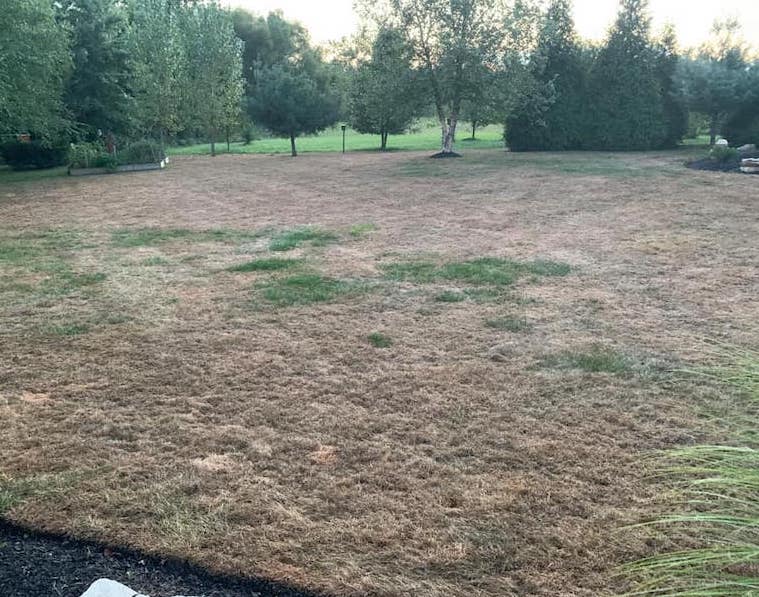Q: I am currently a bit concerned that we will not be able to accomplish our fall overseeding work this year by October 1 due to the ongoing labor issue and now potential damage from fall armyworms. Would you have any guidance or recommendations for repairing these damaged areas, including dormant seeding?
A: The great fall armyworm invasion of 2021 is something for the books, and not something anyone expected. Fall armyworms (FAW) are tropical pests that got carried up to the north on summer storm systems. The adult moths dropped from the skies and laid eggs, which hatched into larvae (caterpillars), which then heartily munched their way through turfgrass leaf tissue on golf courses, sports fields and lawns. The damage was quick, widespread and unexpected. Some turf areas that were treated with insecticides such as Acelepryn in the spring or early summer seem to have avoided damage. Conversely, grasses that we thought might be immune to attack, like turf type tall fescue containing endophytes, were eaten. This will lead to discussions about endophytic grasses and how age of seed and storage methods might affect levels of alkaloids in the turf plant. As I’m writing this, BugDoc (Dr. Dave Shetlar) told me that the FAW larvae have now pupated, with new adults emerging and laying eggs. The cycle from egg to feeding larva is only about 30 days, so we must remain vigilant for round two of FAW damage this fall. Leading up to the first frosts in October, it would be wise to keep an eye on new grass areas to scout for any larval damage, and to possibly apply a low rate of Acelepryn or Tetrino as a curative and future preventive control. If larvae are seen, a liquid application on a pyrethroid product would offer a quick knockdown. Granular products are effective, but need rain or irrigation for activation.
To help the damaged turf recover, protect the turf plant crowns by limiting any kind of mechanical injury (mowing, scarifying, coring etc.) and keeping the crowns hydrated. Avoid the temptation to apply too much fertilizer to turf at this time, as there is research to suggest that the female moths detect areas of lush, fertile turf and lay their eggs accordingly. If damaged turf got very dry and it looks like the crowns will not sufficiently recover, overseeding or slit-seeding may be necessary. October 1 is a sound cut-off date for seeding to make sure new seedlings are established well before the first frosts, but look at the long-range forecast and maybe push that window a little. Quick-germinating species such as perennial or tetraploid ryegrasses will provide quicker ground cover than turf-type tall fescue, and much quicker ground cover than Kentucky bluegrass. However, it appears that FAW is not feeding on Kentucky bluegrass turf, so plan on using bluegrass seed in damaged areas. If it’s too late to do that now, apply it as a dormant seed. If possible, use growth blankets to retain moisture and heat, and to keep people off renovated areas. A growth blanket is one tool that can help save labor, since turf under the blanket needs less frequent watering and other care. Once the window for seed germination has passed, usually around mid to late October, plan to continue renovation efforts in late winter. In February-March 2022, if there is no snow cover, and if weather allows, apply dormant seed to bare/thin spots, using walk-behind equipment that won’t cause soil disruption and compaction. During the freezing and thawing cycles in late winter, the soil structure changes due to the swelling and shrinkage of soil particles, the volume of frost-susceptible soils increases, and pores expand due to ice expansion during freezing. These soil pores offer a great opportunity for seed:soil contact. Once the soil temperatures get consistently about 50 degrees Fahrenheit, the seed is in place to germinate. Dormant seeding offers a kick-start to the season, but seed rates should be slightly higher to compensate for any seed loss. Dormant seeding during the “off” season might also offer a benefit to turf managers who are struggling with labor during the busy season. Since infestations of FAW are typically on a 3 to 7-year cycle, it is hoped that we do not have to deal with this again in 2022. However, if the last two years have taught us anything, be prepared for all possibilities!
Pamela Sherratt
Sports turf extension specialist
The Ohio State University
Questions?
Send them to Pamela Sherratt at 202D Kottman Hall, 2001 Coffey Road, Columbus, OH 43210 or sherratt.1@osu.edu
Or, send your question to Dr. Grady Miller, North Carolina State University, Box 7620, Raleigh, NC 27695-7620, or grady_miller@ncsu.edu



